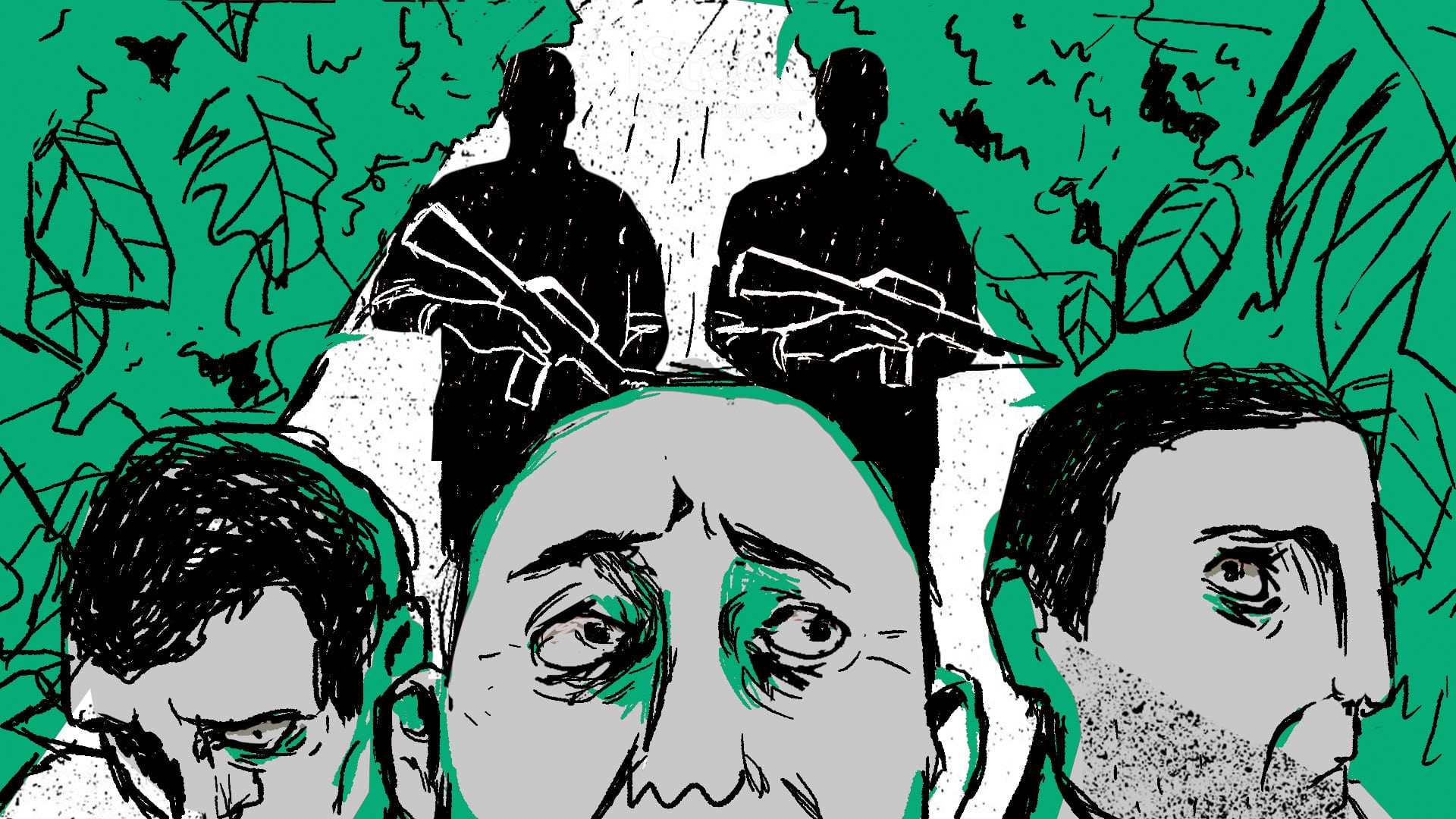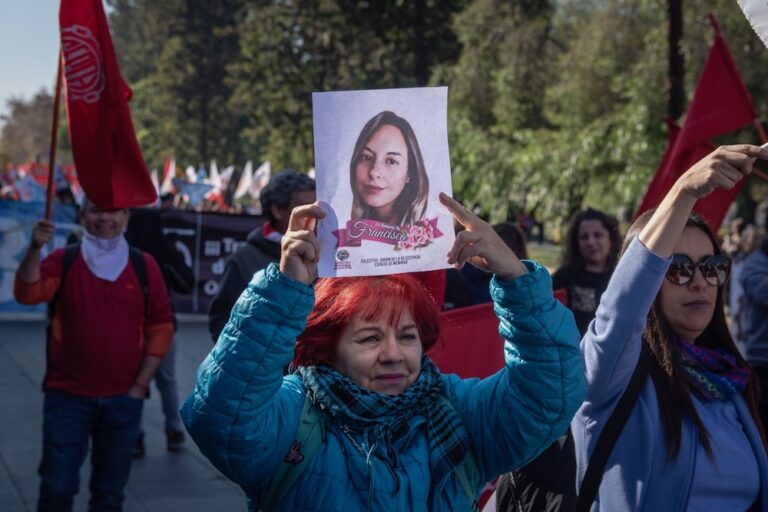Almost seven months ago, journalists Javier Ortega, Paul Rivas, and Efrain Segarra were abducted and killed at the border between Ecuador and Colombia. A team of 20 reporters investigated what happened.
Javier Ortega, Paúl Rivas and Efraín Segarra were killed when they were shot at point-blank on a dark and rainy night in the middle of the Colombian jungle. Ortega, a reporter; Rivas, a photographer; and Segarra, a driver, were all employees of the Ecuadorian newspaper El Comercio kidnapped on March 26th, 2018, by the Frente Oliver Sinisterra – a breakaway faction of the FARC (Fuerzas Armadas Revolucionarias de Colombia). The Frente is led by ex-combatant Walther Patricio Arizala Vernaza, also known in Colombia as Luis Alfredo Pai Jiménez. In both Ecuador and Colombia he has the same alias: “Guacho”.
For six months, a team of journalists from both countries inquired after the reasons for the kidnapping and the circumstances surrounding their execution. The research, titled Death on the Border: The Slain Journalists’ Last Days, also reveals details that the governments of Ecuador and Colombia had knowledge of and decided to not to publicize.
Ortega, Rivas and Segarra were on a reporting trip in the Ecuadorian province of Esmeraldas, on the border with Colombia, where at the beginning of 2018 the Frente Olivera Sinisterra had set off a bomb in a police station, leaving four Ecuadorian soldiers dead.
On March 25th the journalists arrived in the border town of San Lorenzo and got accommodation at a hotel. They left the hotel at 7:10am the next morning, and at 9:00am they cleared the military control point at Mataje, near the border. At that point, according to Ecuadorian authorities, their location was registered and they were warned about the danger in the area.
They continued, parked in the area of Mataje Nuevo and went for a walk. People in the town said that someone approached them; they spoke with and then followed the person. “They were following a man”, an anonymous source said, “They got into a canoe and were taken to the other side. They went without being pressured, when they got there they were told they were being detained”.
At 5:00pm on March 26th, Alejandro Zaldumbide, Ecuadorian Police Major, and Head of Logistics Management of the San Lorenzo Surveillance District, received a message from someone identifying himself as “Guacho”. The sender said he was holding three Ecuadorians, “two journalists and a driver”, and asked for a response within 10 minutes, or else “the men would disappear”.
During the short chat, Zaldumbide – who ended up spending two months communicating with this person – greeted the kidnapper courteously and with familiarity: “Regards, Guacho. Good afternoon. Can I call you?”. To which he replied: “You know I don’t take any calls”. Zaldumbide insisted: “I would like to talk to you”. However, “Guacho” refused and warned the police official he was waiting for a clear answer from him. Otherwise, he said, “every day there will be military and civilian casualties”. Then he said good-bye and sent pictures of the hostages in which they appeared to be wearing the same clothing they were in when they left their hotel. That night, the journalists’ relatives were contacted, but the kidnapping was only officially announced until the next day in a press conference, where the names of the captives were not mentioned. This was the start of the secrecy that is still ongoing.
Six months after the abduction and murder of Ortega, Rivas and Segarra, the governments of Ecuador and Colombia have not provided clear answers about what happened. In the beginning, Juan Manuel Santos, who was Colombia’s president at the time, asserted that the kidnapping had occurred in Ecuador; and, that alias “Guacho” was Ecuadorian. He later retracted this statement. For its part, the government of Ecuador has not yet publicized the fact that on March 28th, when there was a rumour that the journalists may be set free, that a rescue operation was organized. This may be the most relevant finding of Death on the Border.
That night, 48 hours after the kidnapping, El Tiempo from Bogotá reported that the three men had been freed. According to the newspaper, its source was “very credibile”. Yadira Aguagallo, Rivas’s partner, told the Frontera Cautiva journalists that the identity of that source was Luis Carlos Villegas, the Colombian Minister of Defense at that time.
In Ecuador, that same day, a prosecutor (whose name is protected for security reasons) waited for the hostages at the naval base of San Lorenzo, to take them to a helicopter bound for Esmeraldas airport, where they would take a flight to Quito. In an interview, the former Minister of Interior, César Navas, confirmed that a plane was prepared to transfer them. Apparently, President Lenín Moreno was informed and the Secretary of Communication was organizing a press conference to announce the outcome. Almost six hours passed, but the journalists never appeared.
Another research finding shows that the government of Ecuador and “Guacho”‘s gang were in continuous communication. Up to today, it is not clear how the exchange of messages took place because the government has refused to provide any information in this regard. However, it is known that the gang had been demanding, since January 2018, the liberation of three of its members detained in Ecuador, and the annulment of an agreement against drug-trafficking signed with Colombia. According to a witness of the Colombian General Attorney’s Office, ignoring these demands led to the murder of Ortega, Rivas and Segarra.
During the long negotiation held between the Ecuadorian government and the kidnappers, there were crossed messages and several threats through Whatsapp. Ecuadorian authorities received images of the captive journalists shackled and at least one video that has not yet been disclosed.
On April 7th, Frente Oliver Sinisterra leaked two videos through the Colombian media. In one of them, while Paúl and Efraín looked to the camera silently, Javier asked for the exchange of the three detainees and for the cancellation of the drug-trafficking agreement: “Mr. President Lenín Moreno, our lives are in your hands,” he said.
On the same day “Guacho” sent the last message to the negotiator with the government of Ecuador. “You must set free my men, or I will kill the journalists. Tell the Minister of Interior, I’m keeping an eye on him and my attacks and bombings will continue. Today at 3 I will send you the video of one of them dead”. Six days later, on April 13th, the President of Ecuador confirmed that the three men had been murdered.
To this day, border towns between Ecuador and Colombia continue to be helpless, beset by fear and under the shadow of silence. On August 1st, 2018, during a visit by the journalist consortium, Mataje felt like a ghost town; no one was out. Despite the suffocating heat, the doors and windows of the houses remained locked. The journalists explored the area, protected by a military caravan and 20 soldiers.
For two decades, towns along the river have been a frontline. On both sides of the border operate groups like Rastrojos and Águilas Negras and breakaway factions of the FARC. Guerrillas Unidas del Pacífico and Ejercito de Liberación Nacional are also there, along with the Autodefensas Gaitanista de Colombia and other criminal gangs such as Gaula NP and Las Lágrimas. All of them freely cross the border between the countries freely and are associated with big drug cartels such as Sinaloa and Jalisto Nueva Generación and Cartel del Golfo.
Just as in San Lorenzo, on the Colombian side in the municipality of Tumaco fear is everywhere. Most people consulted by the journalist consortium did not allow their interviews to be recorded, not even on audio, for fear of retaliation. People on both sides of the border are used in the drug-trafficking chain. In Ecuador, specifically in Mataje Nuevo, they keep weapons and money in secret warehouses. The laboratories for processing the coca leaves are located in Campanita, 8 kilometres upstream from Mataje. There are hired killers in more urban areas such as San Lorenzo as well. A judicial official, who spoke on condition of anonymity, added that this part of the border serves to supply fuels and materials for the manufacture of cocaine that is exported from the Colombian side. Tumaco is the municipality with the largest coca fields in the world.
Ecuador confirmed its preference for a negotiated solution and discarded a military operation to rescue Ortega, Rivas and Segarra. However, the calculations went wrong. At some point, the three journalists were taken to Los Cocos, very close to the river Mira, a natural border between the two countries. According to a witness with the Colombian General Attorney’s Office, Efraín Segarra, the oldest of the three, understood his fate was sealed and asked their captor if they were going to be killed. “Perú”, a hitman, answered: “Yes, because the Ecuadorian Government did not comply with the deal.”
It would take more than two months for forensic teams and police to rescue the bodies on June 21st. When they were found, Ortega, Rivas and Segarra no longer wore the chains that had held them captive. A flurry of 17 bullets had rendered them unnecessary.
On September 15th, Iván Duque, the new elected President of Colombia, stated that “Guacho” was injured and escaped from a military operation in the area. Two days later, the Commander of Military Forces, General Alberto Mejía, said he could not “confirm or deny” this news.
Yadira Aguagallo, Paúl Rivas’ partner, said in a radio interview that for the families of the victims it is imperative that “Guacho” is captured alive, and they be able to take a “step forward against impunity”. In other words, to learn the truth that three families and two countries are longing for.




